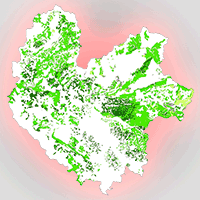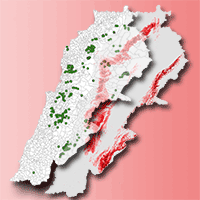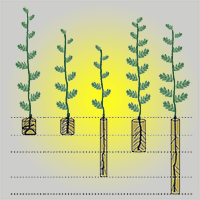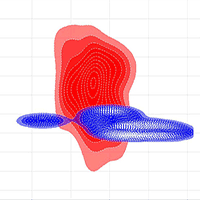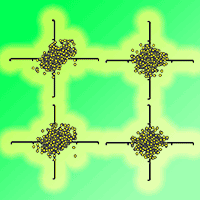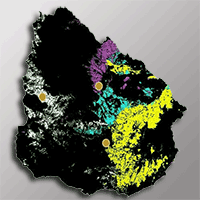Onsite information pertaining to forest growth potential is a significant prerequisite for selecting suitable forest plantation locations and safeguards sustainable timber production and income generation. In the scope of forest landscape restoration, the selection of the most suitable sites for reforestation remains a major issue. The current study introduces an operational, objective, and straightforward methodology for the identification and prioritization of sites that are suitable for forest plantations. The methodology is based on an approach that combines land use suitability assessment with site-specific growth and yield predictions. The land use suitability assessment is based on a methodological framework presented by the Food and Agriculture Organization (FAO). In a study area in Vietnam four different suitability classes are defined for the species Acacia mangium (A. mangium). Field assessments in existing A. mangium plantations were utilized to develop yield models. Among the Korf, Gompertz, and Chapman-Richards growth equations Korf performed the best for all suitability classes. Prioritization of sites is realized by the analytical hierarchy process (AHP). Our study offers a pragmatic approach for selecting the most suitable sites for large-scale forest restoration activities. Integrating growth and yield predictions supports reforestation practices and promotes sustainable timber production.
Keywords
, , , ,
Citation
Cuong ND, Volker M, Köhl M (2019). Facilitating objective forest land use decisions by site classification and tree growth modeling: a case study from Vietnam. iForest 12: 542-550. - doi: 10.3832/ifor2945-012
Academic Editor
Emanuele Lingua
Paper history
Received: Aug 08, 2018
Accepted: Aug 27, 2019
First online: Dec 17, 2019
Publication Date: Dec 31, 2019
Publication Time: 3.73 months
© SISEF - The Italian Society of Silviculture and Forest Ecology 2019
Open Access
This article is distributed under the terms of the Creative Commons Attribution-Non Commercial 4.0 International (https://creativecommons.org/licenses/by-nc/4.0/), which permits unrestricted use, distribution, and reproduction in any medium, provided you give appropriate credit to the original author(s) and the source, provide a link to the Creative Commons license, and indicate if changes were made.

Breakdown by View Type
(Waiting for server response...)
Article Usage
Total Article Views: 45527
(from publication date up to now)
Breakdown by View Type
HTML Page Views: 40115
Abstract Page Views: 2546
PDF Downloads: 2059
Citation/Reference Downloads: 4
XML Downloads: 803
Web Metrics
Days since publication: 2188
Overall contacts: 45527
Avg. contacts per week: 145.65
Article Citations
Article citations are based on data periodically collected from the Clarivate Web of Science web site
(last update: Mar 2025)
Total number of cites (since 2019): 6
Average cites per year: 0.86
Publication Metrics
by Dimensions ©
Articles citing this article
List of the papers citing this article based on CrossRef Cited-by.
(1)
Amaro A, Reed D, Soares P (2003)Modelling forest systems. CABI Publishing, Wallingford, UK, pp. 416.
Online |
Gscholar
(2)
Anh BTK, Kim DD, Tua TV, Kine NT, Anh DT (2011)Phytoremediation potential of indigenous plants from Thai Nguyen province, Vietnam. Journal of Environmental Biology 32 (2): 257-262.
Online |
Gscholar
(3)
Battaglia M, Sand PJ (1998)Process-based forest productivity models and their application in forest management. Forest Ecology and Management 102 (1): 13-32.
CrossRef |
Gscholar
(4)
Berrill JP (2004)Preliminary growth and yield models for even-aged
Cupressus lusitanica and C. macrocarpa plantations in New Zealand. New Zealand Journal of Forestry Science 34 (3): 272-292.
Online |
Gscholar
(5)
Bonan GB (2008)Forests and climate change: forcings, feedbacks, and the climate benefits of forests. Science 320 (5882): 1444-1449.
CrossRef |
Gscholar
(6)
Borges JG, Mcdill ME, Balteiro LD, Rodriguez LCE (2014)Managing forest ecosystems. In: “The Management of Industrial Forest Plantations”, vol. 33, Springer, Dordrecht Heidelberg New York London, pp. 544.
Gscholar
(7)
Burkhart HE, Tomé M (2012)Modeling forest trees and stands. Springer Science+Business Media, Dordrecht, The Netherlands, pp. 461.
Online |
Gscholar
(8)
Chazdon RL (2008)Beyond deforestation: restoring forests and ecosystem services on degraded lands. Science 320: 1458-1460.
CrossRef |
Gscholar
(9)
Chazdon RL, Guarigueta MR (2018)Decision support tools for forest landscape restoration. CIFOR, Bogor Barat, Indonesia, pp. 70.
Gscholar
(10)
Clement F, Amezaga JM (2009)Afforestation and forestry land allocation in northern Vietnam: analysing the gap between policy intentions and outcomes. Land Use Policy 26 (2): 458-470.
CrossRef |
Gscholar
(11)
De Jong W, Sam DD, Hung TV (2006)Forest rehabilitation in Vietnam histories, realities and future. CIFOR, Bogor, Indonesia, pp. 90.
Online |
Gscholar
(12)
Eastman LR, Jin W, Kyem PAK, Toledano J (1995)Raster procedures for decisions multi-criteria/multi-objective decision. Photogrammetric Engineering and Remote Sensing 61 (5): 539-547.
Gscholar
(13)
EU-FLEGT (2011)Baseline study 3, Vietnam, overview of forest law enforcement, governance and trade. European Forest Institute - FLEGT Asia Regional Office, Kuala Lumpur, Malaysia, pp. 51.
Gscholar
(14)
Ewers RM, Scharlemann JPW, Balmford A, Green RE (2009)Do increases in agricultural yield spare land for nature? Global Change Biology 15 (7): 1716-1726.
CrossRef |
Gscholar
(15)
FAO (1984)Land evaluation for forestry. Food and Agriculture Organization of the United Nations, Rome, Italy, pp. 130.
Gscholar
(16)
FAO (2005)Global forest resources assessment 2005: progress towards sustainable forest management. Food and Agriculture Organization of the United Nations, Rome, Italy, pp. 350.
Gscholar
(17)
FAO (2007)Land evaluation: towards a revised framework. Land and Water Discussion Paper no. 6, Food and Agriculture Organization of the United Nations, Rome, Italy, pp. 124.
Gscholar
(18)
FAO (2010)Global forest resources assessment 2010. Food and Agriculture Organization of the United Nations, Rome, Italy, pp. 378.
Gscholar
(19)
FAO (2015a)Global forest resources assessment 2015 - How are the world’s forests changing? Food and Agriculture Organization of the United Nations, Rome, Italy, pp. 56.
Gscholar
(20)
FAO (2015b)Global forest resources assessment 2015 - Desk reference. Food and Agriculture Organization of the United Nations, Rome, Italy, pp. 253.
Gscholar
(21)
Feizizadeh B, Jankowski P, Blaschke T (2014)A GIS-based spatially-explicit sensitivity and uncertainty analysis approach for multi-criteria decision analysis. Computers and Geosciences 64: 81-95.
CrossRef |
Gscholar
(22)
Harwood CE, Nambiar EKS (2014)Sustainable plantation forestry in South-East Asia. ACIAR Technical Reports no. 84, Australian Centre for International Agricultural Research, Canberra, Australia, pp. 100.
Online |
Gscholar
(23)
Heilmayr R (2014)Conservation through intensification? The effects of plantations on natural forests. Ecological Economics 105: 204-210.
CrossRef |
Gscholar
(24)
Hung TD, Herbohn JL, Lamb D, Nhan HD (2011)Growth and production varies between pair-wise mixtures and monoculture plantations in North Vietnam. Forest Ecology and Management 262 (3): 440-448.
CrossRef |
Gscholar
(25)
Huu-Dung N, Yeo-Chang Y (2012)Forest policy and economics optimum harvesting time and clone choices for Eucalyptus growers in Vietnam. Forest Policy and Economics 15: 60-69.
CrossRef |
Gscholar
(26)
Kangas A, Kurttila Mi Hujala T, Eyvindson K, Kangas J (2015)Decision support for forest management. Managing Forest Ecosystems, vol. 30, Springer International Publishing, Cham, Switzerland, pp. 310.
Gscholar
(27)
Khuc QV, Tran BQ, Meyfroidt P, Paschke MW (2018)Drivers of deforestation and forest degradation in Vietnam: an exploratory analysis at the national level. Forest Policy and Economics 90: 128-141.
CrossRef |
Gscholar
(28)
Köhl M, Magnussen S, Marchetti M (2006)Sampling methods, remote sensing and GIS multiresource forest inventory. Tropical forestry series, Springer-Verlag, Berlin Heidelberg, pp. 388.
Online |
Gscholar
(29)
Krisnawati H, Kallio MH, Kanninen M, Markku K, Haruni K (2011)Acacia mangium Willd.: ecology, silviculture and productivity. CIFOR, Bogor, Indonesia, pp. 26.
Online |
Gscholar
(30)
Le HD, Smith C, Herbohn J (2014)What drives the success of reforestation projects in tropical developing countries? The case of the Philippines. Global Environmental Change 24 (1): 334-348.
CrossRef |
Gscholar
(31)
Mansourian S (2017)Governance and forest landscape restoration: a framework to support decision-making. Journal for Nature Conservation 37: 21-30.
CrossRef |
Gscholar
(32)
Mishra AK, Deep S, Choudhary A (2015)Identification of suitable sites for organic farming using AHP and GIS. The Egyptian Journal of Remote Sensing and Space Science 18 (2): 181-193.
CrossRef |
Gscholar
(33)
Murayama Y (2012)Progress in geospatial analysis. Springer, Tokio, Japan, pp. 294.
Online |
Gscholar
(34)
Nekhay O, Arriaza M, Guzmán-álvarez JR (2009)Spatial analysis of the suitability of olive plantations for wildlife habitat restoration. Computers and Electronics in Agriculture 65 (1): 49-64.
CrossRef |
Gscholar
(35)
Neupane PR, Gauli A, Marasenii T, Kübler D, Mundhenk P, Dang MV, Köhl M (2017)A segregated assessment of total carbon stocks by the mode of origin and ecological functions of forests: implication on restoration potential. International Forestry Review 19 (4): 120-147.
CrossRef |
Gscholar
(36)
Pham TT, Moeliono M, Nguyen TH, Nguyen HT, Vu TH (2012)The context of REDD+ in Vietnam: drivers, agents and institutions. Occasional Paper 75, CIFOR, Bogor, Indonesia, pp. 98.
Gscholar
(37)
Pistorius T, Paul J, Ho DTH, Nicolas W (2016)Progressing towards the implementation of sustainable forestry business models in the context of REDD + in Vietnam improved forest management in the context of SFM. UNIQUE forestry and land use GmbH, Freiburg, Germany, pp. 36.
Gscholar
(38)
Pretzsch H (2009)Forest dynamics, growth and yield. Springer-Verlag, Berlin Heidelberg, Germany, pp. 664.
CrossRef |
Gscholar
(39)
R Core Team (2013)A language and environment for statistical computing. R Foundation for Statistical Computing, Vienna, Austria.
Online |
Gscholar
(40)
Ryan PJ, Harper RJ, Laffan Mi Booth TH, Mckenzie NJ (2002)Site assessment for farm forestry in Australia and its relationship to scale, productivity and sustainability. Forest Ecology and Management 171 (1-2): 133-152.
CrossRef |
Gscholar
(41)
Saaty TL, Peniwati K (2008)Group decision making. Drawing out and reconciling differences. RWS Publications, Pittsburgh, PA, USA, pp. 385.
Gscholar
(42)
Saaty TL, Vargas LG (2012)Models, methods, concepts and applications of the analytic hierarchy process. Springer Science+Business Media, New York, USA, pp. 346.
Gscholar
(43)
Sedjo RA (1999)The potential of high-yield plantation forestry for meeting timber needs. New Forests 17: 339-359.
CrossRef |
Gscholar
(44)
Sein CC, Mitlöhner R (2011)Acacia mangium Willd. Ecology and silviculture in Vietnam. CIFOR, Bogor, Indonesia, pp. 26.
Online |
Gscholar
(45)
Shi X, Elmore A, Li Xi Gorence NJ, Jin H, Zhang X, Wang F (2008)Using spatial information technologies to select sites for biomass power plants: a case study in Guangdong Province, China. Biomass and Bioenergy 32 (1): 35-43.
CrossRef |
Gscholar
(46)
Skovsgaard JP, Vanclay JK (2008)Forest site productivity: a review of the evolution of dendrometric concepts for even-aged stands. Forestry 81 (1): 13-31.
CrossRef |
Gscholar
(47)
Steward GA, Kimberley MO, Mason EG, Dungey HS (2014)Growth and productivity of New Zealand kauri (
Agathis australis (D. Don) Lindl.) in planted forests. New Zealand Journal of Forestry Science 44 (1): 27.
CrossRef |
Gscholar
(48)
Tewari VP, Kumar VK (2005)Growth and yield functions for
Dalbergia Sissoo plantation in the hot desert of india grown under irrigated conditions. Journal of Tropical Forest Science 17 (1): 87-103.
Online |
Gscholar
(49)
Tewari VP, Verma A, Kumar VK (2002)Growth and yield functions for irrigated plantations of
Eucalyptus camaldulensis in the hot desert of India. Bioresource Technology 85 (2): 137-146.
CrossRef |
Gscholar
(50)
Vaidya OS, Kumar S (2006)Analytic hierarchy process: an overview of applications. European Journal of Operational Research 169: 1-29.
CrossRef |
Gscholar
